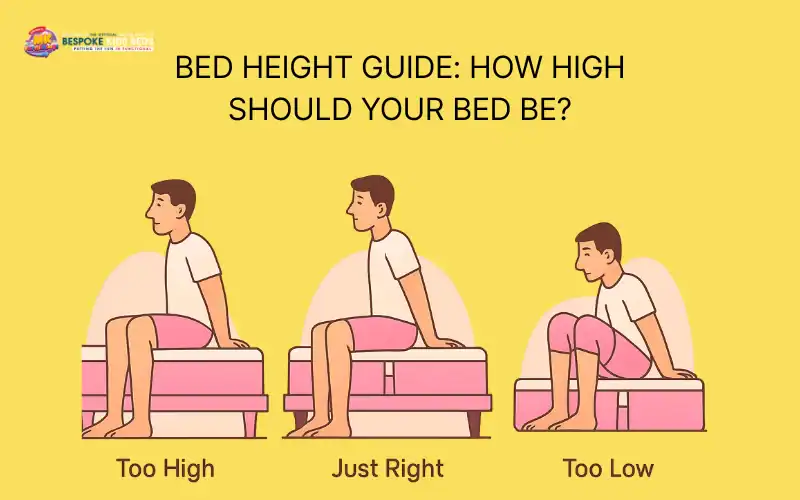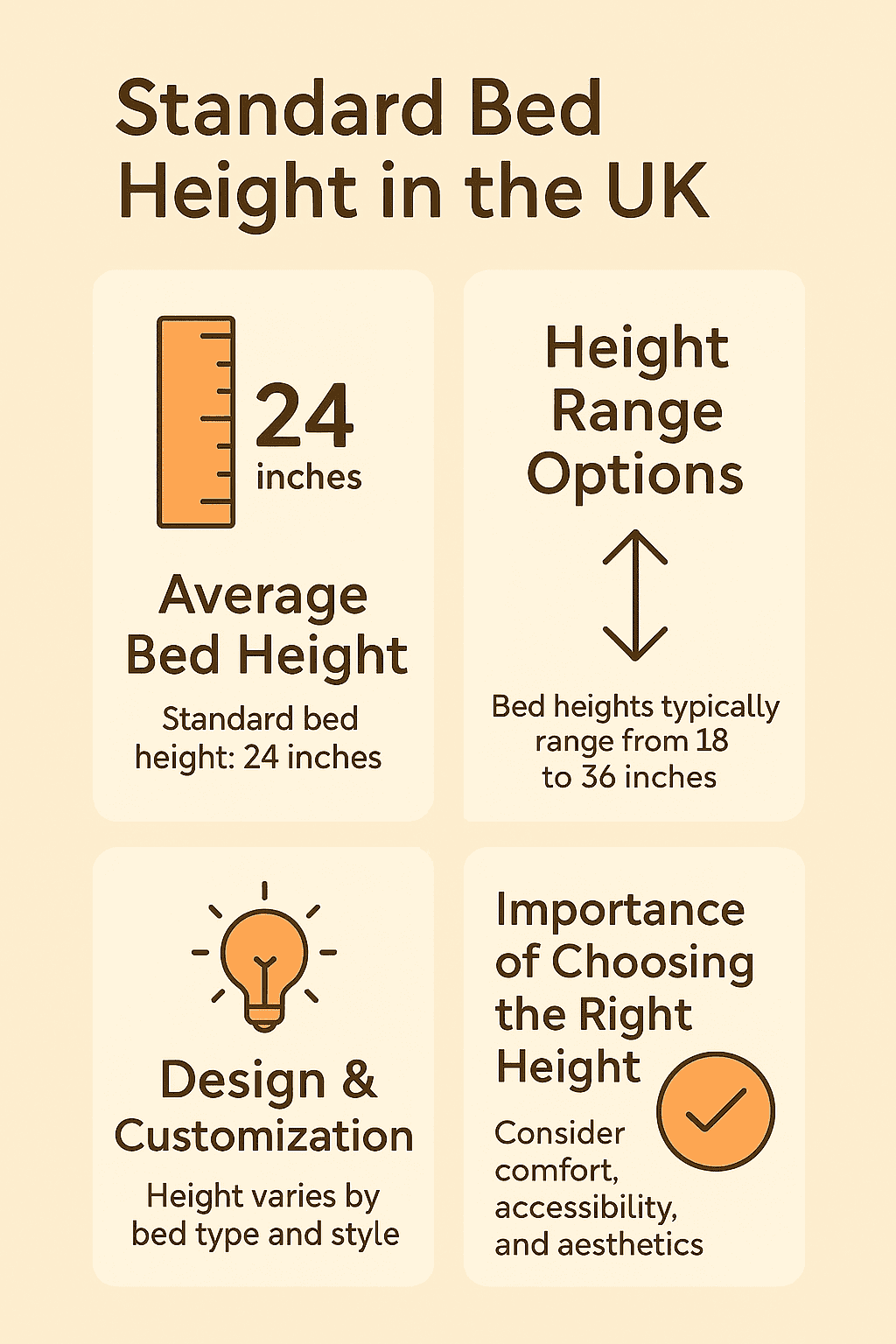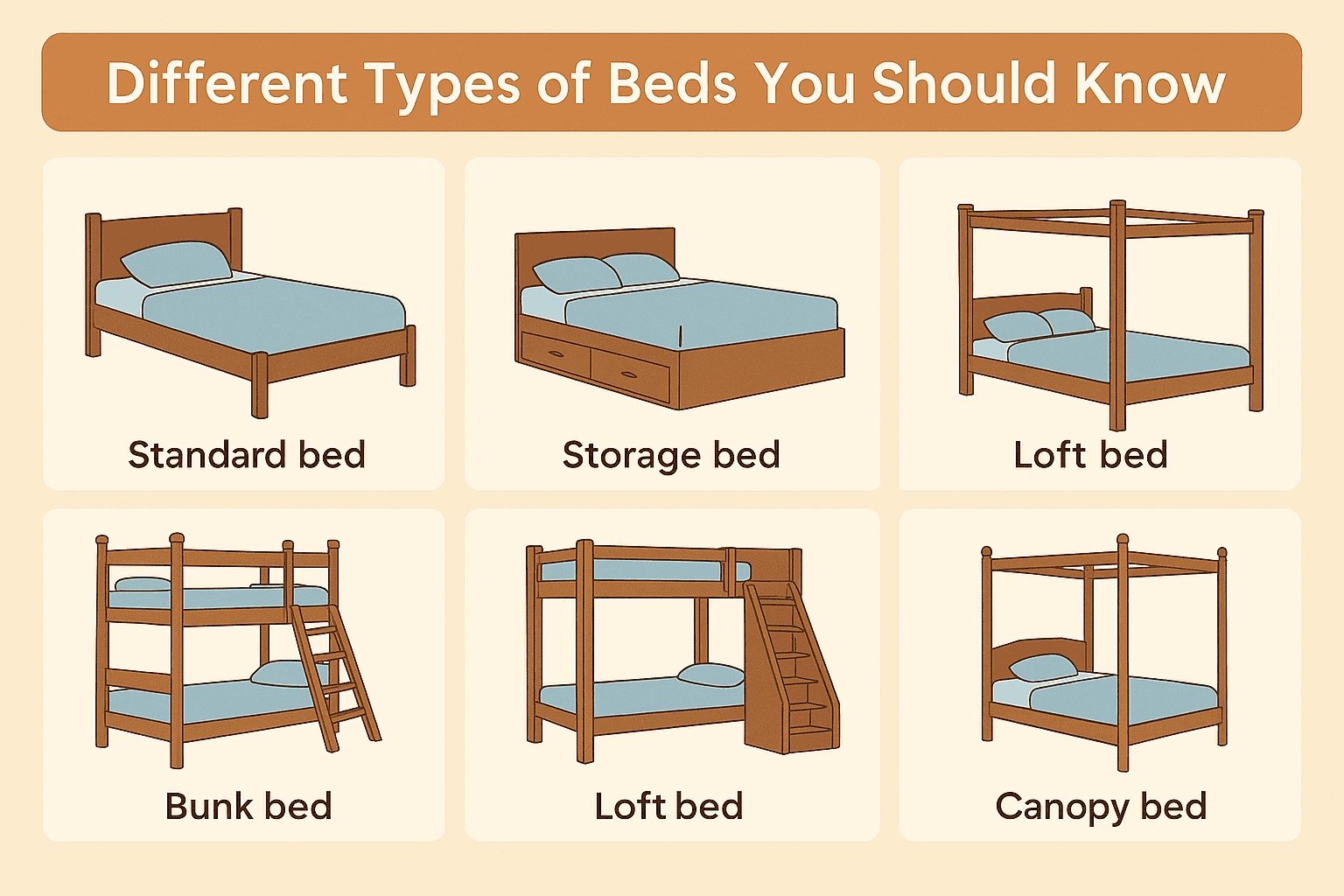
Creative Ideas to Maximise Storage Space in Small Bedrooms
To maximise storage space in a small bedroom, focus on utilising vertical space with shelves or tall cabinets, and opt for multifunctional furniture like bunk
Enjoy FREE Delivery on All Orders!

When buying a new bed, many people prioritise design, colour, or material and they often overlook a critical factor: bed height. The right bed elevation can significantly affect your daily comfort and long-term health. Tall beds can be difficult for seniors or individuals with mobility issues to climb into, while low-profile beds may not provide adequate support or legroom for taller individuals. Whether you’re choosing a bed for better joint support, following Feng Shui principles, looking for extra under-bed storage, or selecting a child-friendly frame, the height of your bed plays a pivotal role in comfort, safety, and functionality.
This comprehensive bed height guide explores the standard and average bed heights, compares different bed frame types, and outlines key factors to help you determine the ideal bed height for your unique needs. If you’re wondering how high should your bed be, read on to find the perfect balance between comfort, practicality, and style.
The standard height of a bed in the UK is 24 inches (60 cm) from the floor to the top of the mattress. This measurement includes the bed frame, foundation such as a box spring or divan base, and the mattress itself.
When shopping for a bed, you’ll come across a wide range of options. Most beds fall between 18 and 36 inches in height, depending on the design, mattress thickness, and whether the bed includes storage.
To calculate the total bed height for your room, use this helpful formula:
Floor clearance + foundation or base height + mattress thickness = total bed height

Why is Bed Height Important?
The height of the bed contributes significantly to your comfort and ease of getting into and out of the bed. Moreover, the ideal bed height also positively influences your health. For example, sitting on a shorter bed can affect your posture when your knees are not properly aligned, and a tall frame bed makes it hard to rest your feet on the floor when sitting on the bed. Similarly, a tall bed may be uncomfortable for kids and people with mobility issues as it requires more effort to get into. Other than comfort and health, selecting the right height can add to the aesthetics of the room, whereas the wrong bed may undermine the effort you have put into decorating the space. While low beds look minimalist and simple, some people find beds with storage more functional and practical. The addition of rolling or pull-out drawers under the bed increases the height of your bed, maximising functionality.
Selecting the right bed height is essential for comfort, safety, and style. Several important factors come into play that can influence your decision, from your personal needs to the design of your room like:
While the standard bed height suits most people, considering your personal needs is critical to buying the right bed. The height of the bed should suit your height – short bed if you have a modest height and a tall bed for those with an above-average height. When buying a bed, sit on its edge (with the mattress on it) and see if your knees align with your hips with your feet flat on the floor. If your feet are not flat on the floor and the knees are below your hips, the bed is too tall for you, and vice versa.
Mobility issues must also be considered when selecting one with an average bed height. The standard bed height might not be suitable for people with a disability and they might find it harder to climb into and out of it. It is better to opt for a bed with a comfortable height to your or your family’s special needs.
Feng Shui is a traditional Chinese practice that focuses on harmony, balance, and positive energy in an area. In Feng Shui, the bed is the most important piece of furniture and the height of the bed is critical for healthy energy flow (Chi) in your bedroom. A tall frame bed can cause too much energy flow, resulting in instability and restlessness. At the same time, a lower bed (such as those sitting on the floor) can block the energy, making you fatigued or depressed.
When finding a bed that matches your ideal bed height preference, make sure to consider the size of the mattress as well. Let’s say you buy one with standard bed height but want to choose a thick mattress; this will make your bed a little too high. Select the bed and mattress height in a way that the total bed height matches your needs.
Room aesthetics are an important consideration for selecting the height of your bed. A low bed gives a minimalistic feel to the room, resembling Japanese style of furniture and aesthetics. However, a taller bed looks more traditional, such as the Victorian era. These beds typically have a tall bed frame, giving them a royal look. Thus, you must opt for a bed height that fulfils your functionality requirements and complements your room decor as well.
Standard bed heights often work well for those who don’t require built-in storage, but if you’re planning to use the space underneath, a slightly taller frame may be more practical. So, if you want pull-out, rolling, or lift-up storage under the bed, the bed needs to be slightly taller than standard beds. The increase in height depends on how tall you want the drawers to be. Alternatively, you can store things in storage cube and bins and push them under the bed frame in the empty space.
The user’s age plays a significant role in determining the bed elevation for their comfort and ease. As we age, our mobility decreases and many older people find it difficult to get in and out of a tall bed, leading to the need for a low or adjustable bed. Similarly, beds particularly designed for toddlers are a better idea when encouraging them to sleep individually.
When selecting a bed frame and mattress for yourself or your family, make sure that it is made of firm and supportive material, such as wood. Moreover, the bed must be safe for young kids as well. Some of the safety considerations for bunk beds are:
Flooring might not seem too crucial when finding a bed, but it can be critical to bunk beds. For example, a tall bed frame in a room with thick flooring will result in lesser head space for the person sleeping in the top bunk. At the same time, a lower bed might seem too sunken into the ground if the floor is cushioned a little too much. To choose the right bed, it is important to ensure stability and enough head space for everyone sharing the bunk bed.
While everything else is important, so is your personal preference and comfort. Other than the textbook considerations for choosing the right bunk bed, pick one that suits your lifestyle and choice. If you do not have any mobility issues, select a bed elevation that is eye-pleasing to the person using the bed and the room.
To make your decision easier, here’s a quick summary of how different factors influence the ideal bed height.
| Factors Considering Bed Height | If the bed is too high | If the bed is too low |
| Your height and mobility | Hard to climb into, especially for short individuals or those with limited mobility | Difficult to stand up from; strain on knees and back |
| Feng shui considerations | Disrupts energy balance | May block energy flow if there’s no space underneath |
| Mattress & frame combination | Tall mattress with a tall bed will make it high and uncomfortable | Lower bed with a thin mattress can cause back pain |
| Room aesthetics & design | Overpowers the room visually, especially in low-ceiling spaces | Can make the room feel flat or empty |
| Under-bed storage needs | May be unnecessarily tall if storage isn’t used efficiently | Lesser under-bed storage options |
| Age group of the user | Seniors may have accessibility issues and children may fall by accident | Uncomfortable for aging joints |
| Safety and stability | More prone to wobbling or tipping if not supported well | May be unsafe if frame is poorly constructed or sharp |
| Flooring type | May feel unstable or damage floors if not well supported | Can feel sunken into the floor |
| Personal comfort & lifestyle | Getting in and out may become inconvenient | Can feel too low to the ground |
There’s more to a bed than just its design. The frame plays a key role in determining how high or low the bed sits. Some frames are suited for compact spaces, while others offer comfort or built-in storage. Here are the different types of bed frames and how each one can influence the overall height and feel of your bed.

Bunk beds refer to two or three beds stacked on top of each other for space maximisation in small rooms. Loft beds are similar to bunk beds, without the bed in the bottom area. Bunk beds are typically 59 to 71 inches tall, whereas loft beds are 67 to 83 inches high. The space underneath the top bunk is empty, and can be utilised in numerous ways; design a play area, set up a study desk, or install shelves for extra storage – the possibilities are limitless. When choosing a bunk bed, avoid selecting a tall bed and ensure at least 33 to 36 inches headroom between the top bunk and the ceiling.
A platform bed is a bed frame that does not require a box spring or an additional foundation to support the bed. It is a lower bed and features a solid surface or a set of slats to hold the mattress. These beds are usually 16 to 18 inches high, compared to the standard bed height of 24 inches from the floor, making them suitable for people who find it hard to climb a tall bed.
The standard height of a bed frame (without a mattress) ranges between 11 and 24 inches, and around 24 inches with a mattress. It is the most common choice among people because of easy accessibility and compatibility with the average person’s height. They feature box spring bed bases on the frame to support the mattress. The box spring reduces stress on the mattress, improving longevity. Though they are bulky, the area under the box spring provides extensive storage space.
Beds with adjustable bases are often selected for elderly with mobility issues. Adjustable beds have a motorised foundation that generally elevates from the head or the foot side. The frame height of the adjustment bed base ranged between 10 and 16 inches. Some people also buy these beds for comfort while sleeping or watching the television, as advanced beds come with options like anti-snore positions.
Low-profile beds are similar to platform beds, but they might have a box spring to support the mattress. They are best for people with a modest height or those who like minimalist furniture. These beds are 6 to 10 inches above the ground without the mattress, and the height with the mattress typically comes around 12 to 14 inches. However, they may not be joint-friendly and should not be opted for seniors with joint issues.
It’s no secret that many of us loved canopy beds with sheer curtains and decorative items as kids. These tall frame beds feature four long posts on each corner of the bed, giving it a grand look. The posts may be connected across the top and adorned with fabric drapes. Canopy and four-poster beds are a better option for tall rooms for a balanced look.
Many beds come with storage options like under the bed drawers, under-the-mattress storage, side tables, and ottomans for extra storage. Storage beds with drawers under the bed are usually 14 to 18 inches tall (without the mattress). For bunk beds, you can also get hanging storage boxes and pegboards to make the best use of available space. Loft beds may also serve the purpose, but they are not best-suited for rooms with low ceilings.
Daybeds are often confused with sofa beds because of their similarity in looks, but they function quite distinctly. Mostly, day beds feature a twin-sized mattress, which offers more width than a regular sofa, making it comfortable for sleeping. Daybeds also come with extra drawers to organise your clutter or a built-in trundle that you can use for sleepovers. Thus, they are similar to storage beds in their height. Daybeds are 14 to 18 inches high without the mattress, and 20 to 26 inches with the mattress. These beds are excellent for rooms with less space and lounge areas where you’d want to take a short nap.
MK Furnishings offers an all-in-one solution to your bunk bed needs with numerous options, including loft beds, storage beds, themed beds, and many other options. When buying from MK Furnishings, you can customise the beds to your family’s needs and select a financing plan that suits your budget the most; we ensure that everyone can buy the best beds for their family’s comfort. We hope this bed height guide helped you understand how tall different beds are, so you can make a more informed decision.
If you’re unsure which bed height is best for your family’s needs, health, or mobility, our team is ready to assist. Get in touch, and we’ll help you find the right bed for your home. Let’s find the right bed for you, together!
Kyle Kane
Owner
Kyle Kane is Co-Owner of MK Furnishings, a family-run business based in UK that specializes in high-quality custom kids’ bunk beds, including triple, double, single, and themed designs. Since launching the company in 2016 alongside his brother-in-law, Kyle has helped deliver and assemble thousands of beds across the UK, Ireland, and beyond. Focused on customer satisfaction, Kyle leads a hardworking team that handles every step from ordering to delivery ensuring a smooth and professional service. His commitment to quality craftsmanship and reliable support has earned MK Furnishings a strong reputation and growing customer base throughout the region.

To maximise storage space in a small bedroom, focus on utilising vertical space with shelves or tall cabinets, and opt for multifunctional furniture like bunk

To dispose of a mattress in the UK, the major options include recycling, local council collection services, charity donations, or retailer take-back schemes. Each option
Fancy £50 off all orders! Enter in 50off to redeem in the coupon code section